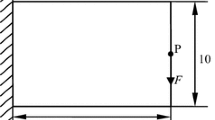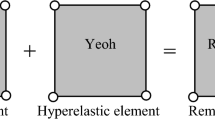Abstract
The material-replacement method is presented to improve the efficiency of topology optimization of a continuum structure with tension-only or compression-only material. Traditionally, a structure with tension-only or compression-only material should be considered as nonlinear in finite element analysis and many times of reanalysis are required to obtain the accurate physical fields for the update of the design variables in optimization. To improve the efficiency of structural optimization, the material-replacement method is proposed, in which the original tension/compression only material is replaced with an isotropic material with the same effective elasticity. The method contents two major ideas. One is the structural reanalysis for nonlinearity of material is put into the global iteration of optimization. The other is that the local stiffness will be modified step by step according to the local stress state. Numerical results show the validity of the method.








Similar content being viewed by others

References
Ambartsumyan SA (1970) Equations of the theory of thermal stresses in double-modulus materials. In: Proc of the IUTAM symposium, East Kilbride, Vienna. Springer, New York
Ambartsumyan SA (1972) On determination of certain mechanical characteristics of materials heteroresistant to tension and compression. The deformation and the rupture of solids subjected to multiaxial stresses. Colloque International, Cannes
ANSYS, Inc, ANSYS (2009) 2009-11-01. http://www.ansys.com
Bendsoe MP (1989) Optimal shape design as a material distribution problem. Struct Optim 1:193–202
Bendsoe MP (1995) Optimization of structural topology, shape and material. Springer, Berlin
Bendsøe MP, Kikuchi N (1988) Generating optimal topologies in structural design using a homogenization method. Comput Methods Appl Mech Eng 71:197–224
Bendsoe MP, Sigmund O (1999) Material interpolation schemes in topology optimization. Arch Appl Mech 69:635–654
Bremicker M, Kikuchi N, Chirehdast M, Papalambros PY (1991) Integrated topology and shape optimization in structural design. Mech Struct Mach 19(4):551–587
Chang CJ, Zheng B, Gea HC (2007) Topology optimization for tension/compression only design. In: Proceedings of the 7th world congress on structural and multidisciplinary optimization, COEX Seoul, Korea, vol 1, pp 2488–2495
Eschenauer HA, Olhoff N (2001) Topology optimization of continuum structures: a review. Appl Mech Rev-ASME 54:331–390
Eschenauer HA, Kobelev VV, Schumacher A (1994) Bubble method for topology and shape optimization of structures. Struct Optim 8:42–51
Green AE, Mktichian JZ (1977) Elastic solids with different moduli in tension and compression. J Elast 7:369–386
Guan H, Steven GP, Xie YM (1999) Evolutionary structural optimisation incorporating tension and compression materials. Adv Struct Eng 2:273–288
Haber RB, Jog CS, Bendsoe MP (1996) A new approach to variable-topology design using a constraint on the perimeter. Struct Optim 11:1–12
Kirsch U (1981) Optimum structural design. McGraw-Hill, USA
Medri G (1982) A nonlinear elastic model for isotropic materials with different behavior in tension and compression. Trans ASME 26:26–28
Olhoff N, Bendsoe MP, Rasmussen J (1991) On CAD-integrated structural topology and design optimization. Comput Methods Appl Mech Eng 89:259–279
Rozvany GIN, Zhou M, Birker T (1992) Generalized shape optimization without homogenization. Struct Optim 4:250–252
Sigmund O (1994) Materials with prescribed constitutive parameters: An inverse homogenization problem. Int J Solids Struct 31:2313–2329
Sigmund O (2001) A 99 line topology optimization code written in Matlab. Struct Multidisc Optim 21:120–127
Svanberg K (1987) The method of moving asymptotes—a new method for structural optimization. Int J Numer Methods Eng 24:359–373
Wang MY, Wang X, Guo D (2003) A level set method for structural topology optimization. Comput Methods Appl Mech Eng 192:227–246
Xie YM, Steven GP (1993) A simple evolutionary procedure for structural optimization. Comput Struct 49:885–896
Xie YM, Felicetti P, Tang JW (2005) Form finding for complex structures using evolutionary structural optimization method. Des Stud 26:55–72
Acknowledgments
Supports for this study are provided by the National Natural Science Foundation of China (Grant No. 50908190). The author would like to give thanks to an anonymous referee for his/her suggestions.
Author information
Authors and Affiliations
Corresponding author
Rights and permissions
About this article
Cite this article
Cai, K. A simple approach to find optimal topology of a continuum with tension-only or compression-only material. Struct Multidisc Optim 43, 827–835 (2011). https://doi.org/10.1007/s00158-010-0614-7
Received:
Revised:
Accepted:
Published:
Issue Date:
DOI: https://doi.org/10.1007/s00158-010-0614-7



